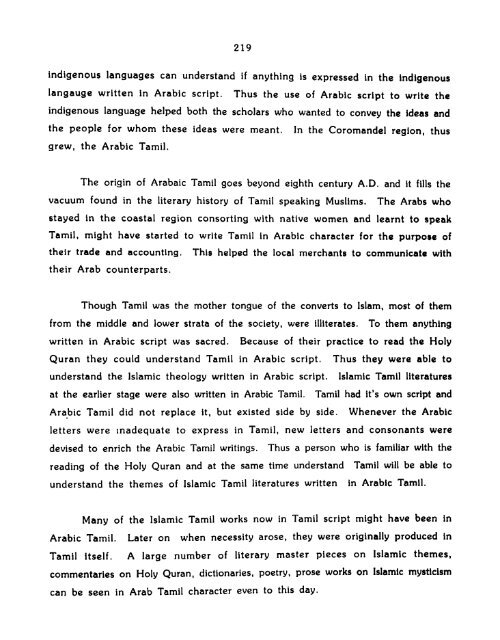maritime activities economy and social customs of the muslims of ...
maritime activities economy and social customs of the muslims of ...
maritime activities economy and social customs of the muslims of ...
Create successful ePaper yourself
Turn your PDF publications into a flip-book with our unique Google optimized e-Paper software.
indigenous languages can underst<strong>and</strong> if anything is expressed in <strong>the</strong> indigenous<br />
langauge written in Arabic script. Thus <strong>the</strong> use <strong>of</strong> Arabic script to write <strong>the</strong><br />
indigenous language helped both <strong>the</strong> scholars who wanted to convey <strong>the</strong> ideas <strong>and</strong><br />
<strong>the</strong> people for whom <strong>the</strong>se ideas were meant. In <strong>the</strong> Corom<strong>and</strong>el region, thus<br />
grew, <strong>the</strong> Arabic Tamil.<br />
The origin <strong>of</strong> Arabaic Tamil goes beyond eighth century A.D. <strong>and</strong> it fills <strong>the</strong><br />
vacuum found in <strong>the</strong> literary history <strong>of</strong> Tamil speaking Muslims. The Arabs who<br />
stayed in <strong>the</strong> coastal region consorting with native women <strong>and</strong> learnt to speak<br />
Tamil, might have started to write Tamil in Arabic character for <strong>the</strong> purpose <strong>of</strong><br />
<strong>the</strong>ir trade <strong>and</strong> accounting. This helped <strong>the</strong> local merchants to communicate with<br />
<strong>the</strong>ir Arab counterparts.<br />
Though Tamil was <strong>the</strong> mo<strong>the</strong>r tongue <strong>of</strong> <strong>the</strong> converts to Islam, most <strong>of</strong> <strong>the</strong>m<br />
from <strong>the</strong> middle <strong>and</strong> lower strata <strong>of</strong> <strong>the</strong> society, were illiterates. To <strong>the</strong>m anything<br />
written in Arabic script was sacred. Because <strong>of</strong> <strong>the</strong>ir practice to read <strong>the</strong> Holy<br />
Quran <strong>the</strong>y could underst<strong>and</strong> Tamil in Arabic script. Thus <strong>the</strong>y were able to<br />
underst<strong>and</strong> <strong>the</strong> lslamic <strong>the</strong>ology written in Arabic script. Islamic Tamil literatures<br />
at <strong>the</strong> earlier stage were also written in Arabic Tamil. Tamil had it's own script <strong>and</strong><br />
Ara,bic Tamil did not replace it, but existed side by side. Whenever <strong>the</strong> Arabic<br />
letters were lnadequate to express in Tamil, new letters <strong>and</strong> consonants were<br />
devised to enrich <strong>the</strong> Arabic Tamil writings. Thus a person who is familiar with <strong>the</strong><br />
reading <strong>of</strong> <strong>the</strong> Holy Quran <strong>and</strong> at <strong>the</strong> same time underst<strong>and</strong> Tamil will be able to<br />
underst<strong>and</strong> <strong>the</strong> <strong>the</strong>mes <strong>of</strong> lslamic Tamil literatures written in Arabic Tamil.<br />
Many <strong>of</strong> <strong>the</strong> lslamic Tamil works now in Tamil script might have been in<br />
Arabic Tamil. Later on when necessity arose, <strong>the</strong>y were originally produced in<br />
Tamil itself. A large number <strong>of</strong> literary master pieces on lslamic <strong>the</strong>mes,<br />
commentaries on Holy Quran, dictionaries, poetry, prose works on Islamic mysticism<br />
can be seen in Arab Tamil character even to this day.

















